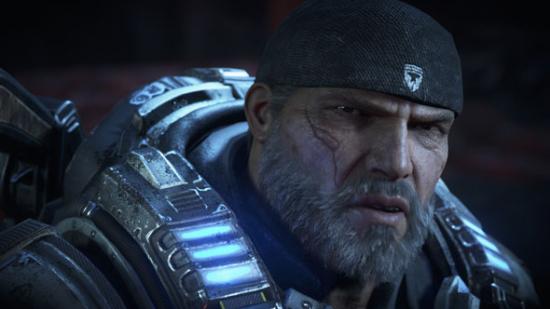There’s not been too much to get excited about so far with Microsoft’s project to fuse its Xbox One and Windows 10 platforms. Quantum Break was a dud, Killer Instinct was a decent but simple port with no added bells and whistles for PC users, and Rise of the Tomb Raider came to Steam just a few months after its underperforming XO launch… hardly the Windows platform exclusive Microsoft were hoping for.
Will Gears 4 good enough to make our list of the best PC games of 2016?
Microsoft’s second run at hosting its own gaming platform on Windows 10 remains a bit of a mystery, but one thing that’s clear is that it needs a flagship title to wave the banner – a title that will compel gamers to leave the comforts of Steam for the strange new territory of the Windows Store. Based on several hours with the campaign and multiplayer, the game to do that might just be Gears of War 4.
And that’s not just to do with its mechanical or narrative quality (more on those later – they’re good, if you insist on knowing now). It’s because Gears of War 4 is the first UWP game not to feel like a lazy port. Too many times have we seen PC versions of multiplatform games butchered by bad porting, scaling back on multiplayer features, or being visually cut down to match their console counterparts. But not here; Gears of War 4 is a powerhouse of a PC game with nothing dropped from the Xbox One version, and an almost daunting degree of graphical customisation – from draw distances, to screen space reflections, to particle spawn rates. Playing the game on a 4K monitor, with a rig packing a GTX 1080, Intel i7 5820 10-core CPU, and an obscene 64GB of RAM was, on a technical level, as close to a spiritual experience as you can get while shooting robots and sawing malicious aliens in two.
Another trailblazing feature of Gears of War 4 is that it’s going to include all the split-screen functionality of the Xbox One version, so you can saddle up with a buddy for the campaign and co-op modes. It may seem strange to call a feature that’s been treated by developers in recent years as archaic as a memory card ‘trailblazing’, but including it is an all-too-rare acknowledgment that PCs are often used these days with a couple of gamepads and a 50-inch TV.
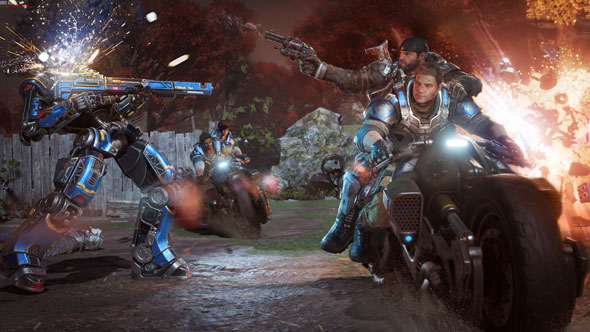
Technical director Mike Rayner was on point when he said, “We don’t want to make the PC game a different experience, we want to make it a better experience”. A controversial thing to hear if you’re an Xbox One owner maybe, but for us long-suffering PC gamers, it’s refreshingly candid. Even before considering how it actually plays, Gears of War 4 on PC is already a technical triumph.
But what of the game itself?
For you sheltered PC gamers wondering what this ‘Gears’ business is all about, it’s a cultishly popular third-person shooter that console gamers played on a last-gen contraption called an ‘Xbox 360’. Back in 2007 it more or less invented cover mechanics, and the stereotype of the ‘grey-and-brown’ modern shooter genre that finally seems to be fading away now. But beneath the meaty, macho veneer of its gameplay and ogre-like heroes, Gears had a soul – its linear, no-nonsense campaign ballasted by a well-written camaraderie between Delta Squad members Marcus Fenix, Cole, Baird and Dom. The sharpness of the series tapered off by the time it got to the fourth entry, Judgment, in 2013; Gears 4 producer Rod Fergusson seemed aware of this when he stated his intentions to pare back the Gears 4 campaign to being an intimate underdog story like the original, rather than the epic war drama of its most recent successors.
Gears 4 pits you as JD, Marcus Fenix’s handsome son who seems to have inherited none of his father’s blocky physique and general bodily wideness that goes from his eyes and nose, right down to his oaken calves (his late mother must’ve been a genetically-dominant stunner). JD and his equally young and beautiful friends, Del and Kait, track down a weathered and grumbling Marcus – whiling away his days in his grand rural home – to warn him of a new alien threat. Fenix is living as an ‘Outsider’ – beyond the walls of the oppressive CoG (that’s Coalition of Ordered Governments) city which zealously protects the remnants of humanity using a robotic security force known as the DeeBees, who you inevitably come into conflict with.
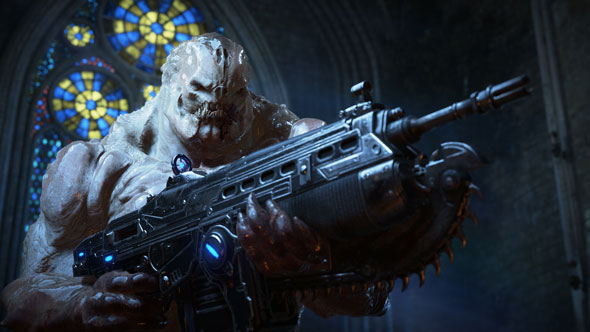
Powering through Act II and Act III of the campaign, I was impressed by the sheer spectacle; lightning storms tearing through the sanguine skies, wonderful impact marks on walls from bullets, violent smouldering marks caused by explosives, and robots being decimated into showers of electric sparks and cogs. It plays fine too, though the few extra moves such as the Yank & Shank that lets you pull enemies over low bits of cover and execute them don’t conceal that this is a straight-down-the-line cover shooter like its predecessors. The motorbike sequence at the end of Act II is the only part that felt a little unsatisfying, playing like a pretty version of Temple Run – I simply pressed left and right to dodge obstacles before taking on a Contra-like boss (which entailed shooting its weapons off one by one while dodging left and right, before blasting its ‘core’ at the end).
No, the campaign in Gears 4 will be defined as it always has been: through visuals and an engaging dynamic between the lead characters. Things start off well. Marcus and JD have an endearingly pissy relationship – the father always assuming the son’s at fault for the trouble he brings to his doorstep – while the family theme that the devs talked so much about shines through at several moments, such as when Marcus hands down his late wife’s armour to Kait. Marcus’ rage as the CoG security bots desecrate his estate meanwhile, offers some welcome comic relief – the righteous fury of a man who just wanted to be left well alone.
After dealing with the robots, there’s a marked tonal shift in Act III, which is deliciously slow-building as the team goes deeper and deeper into Swarm territory, steadily making grisly discoveries until the big confrontation. When you do finally encounter the Swarm, they’re very much equivalent to the Locust of earlier games. So you have your flushers, pinners and soldiers, though the cunning Pouncer can do both – hurling goo from a distance, then leaping onto the cover in front of you, or even right on top of you. They make for some good set-pieces, these Swarmsters, such as when tens of the monkey-like Juvies come scurrying over the Gothic-inspired rooftops of a city, whooping as they close the distance at an alarming pace. Certainly more gripping and volatile than the rigid robot encounters from the earlier levels.
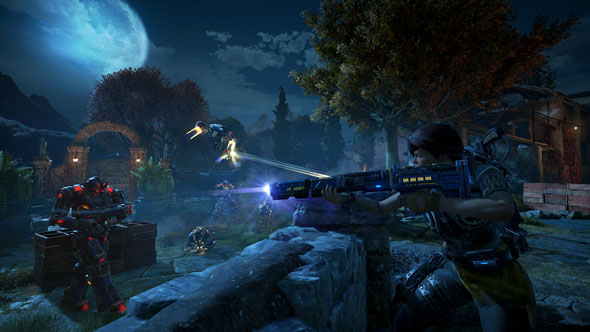
One of the big questions that remains around the campaign is whether these spritely new characters can become as iconic as their forebears. They’ve got some big shoes to fill – literally and figuratively – and when towards the end of my play session they got separated from Marcus, I immediately felt his loss in the group. Perhaps it’s a sign of my own ageing that I found his cynicism and old-school Gears gruffness more relatable than the millennial joshing of JD, Del and Kait. Thankfully, there will be a couple of new senior characters entering the fray in the form of Oscar and Kait’s mother Reyna, and hopefully they’ll infuse that extra bit of grit into the Gears squad.
After the relative ease of mowing down AI enemies in the campaign, I was apprehensive about taking on other – probably superior – players in the competitive online mode. The Coalition told us that their main target demographic was new players, though this is to be reflected far more in the matchmaking than the mechanics, which are a refinement of what came before rather than any significant kind of overhaul. As with the single-player, it’s a case of evolution rather than revolution, polishing the game for the big eSports push they’re planning upon its release.
As I anticipated, multiplayer was a personal failure for me. In the zone-capturing Escalation mode, I’d get gunned down and executed via cudgelling thrice for every satisfying kill I pulled off, and struggled to build any kind of momentum. I had a lot more joy on the more chaotic Arms Race, where every three kills your entire team would be switched onto another weapon. It was fast, eclectic, and good primitive fun. True to Gears history, the level design is sprawling rather than vertical, with a focus as ever on flanking, and audacious sprints from cover to cover as your buddies pin down the enemy. You can forget about camping in some sneaky little sniping spots in some tucked-away foliage on the map – the battlefronts are constantly shifting and you’re always adapting to them.
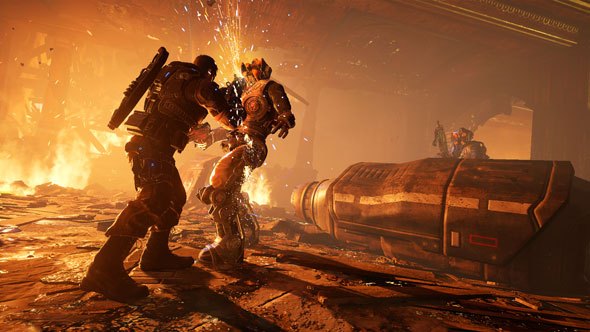
The biggest changes come in the legendary Horde mode – GoW’s slant on co-op wave survival, now with distinct character classes, completely open placement of defensive structures, and cards offering a huge variety of boosts for your class. It’s great fun figuring out the optimal points on the map for setting up your defences, then building a bespoke fortress of turrets, sentries and barbed wire around the existing architecture.
After a few botched early efforts, where my team kept setting up its defences in easily surrounded areas, and hadn’t quite worked out which roles suited our respective skills (or lack thereof) best, we finally got into a groove on a map called Dam. I picked the Heavy, an expert of explosives, heavy weapons and (most importantly) turrets. We set up camp near a corner of the map that had a view of almost the entire battlefield. We had a soldier on the back of a pickup truck, a scout running in and doing some close-range damage (and picking up power points off fallen foes that we used to buy upgrades), me on the turret, and an engineer thanklessly but meticulously repairing our defences between rounds, gaining seemingly no points for his efforts (if he’d gone on pre-emptive strike, I’d have completely understood).
The resultant match was a harmonious dance of destruction. From my meticulously, almost game-breakingly, placed turret, I blithely gunned down untold Swarm and DeeBees seconds after they emerged from one of their spawn points. The defences worked beautifully: automated machine guns doing midrange damage, shock sentries zapping enemies who got ensnared in the barbed wire, and every player staying within the boundaries of their role. We reached Wave 48 of 50 when disaster struck, and two precise Dropshot grenades seconds apart landed right on top of me. I was helped up by a teammate but my pricey Level 3 turret was destroyed, and I wasn’t nearly as useful with my measly grenade launcher that I’d barely used until that point.
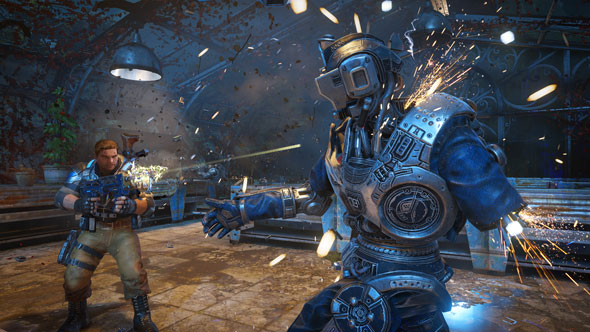
Off the back of that one freak attack, the team was quickly annihilated. We tried a couple of restarts from the same wave, but deprived of our turret, other defences, and the funding to renew them, we couldn’t get back into a rhythm. Besides, the prospect of completing the whole Horde mode without dying once was now gone. A victory at this point wouldn’t have been a pure one anyway, so I bowed out with my head held high, yet wondering if I’ll ever achieve such GoW greatness again.
It’s in these co-op moments that I got the greatest joy from Gears of War 4, though the competitive mode will also probably find a whole new wave of admirers on the PC, which already feels like the most natural platform for this most iconic of former Xbox exclusives. Will it recapture that same single-player spirit that so unexpectedly proved that gritty war shooters can be wonderfully told stories? I’m not sure, though the option to play through the campaign in split-screen alongside a buddy on PC is such a novelty with such potential for creating our own memorable stories and experiences, that it’ll be a blast either way.
